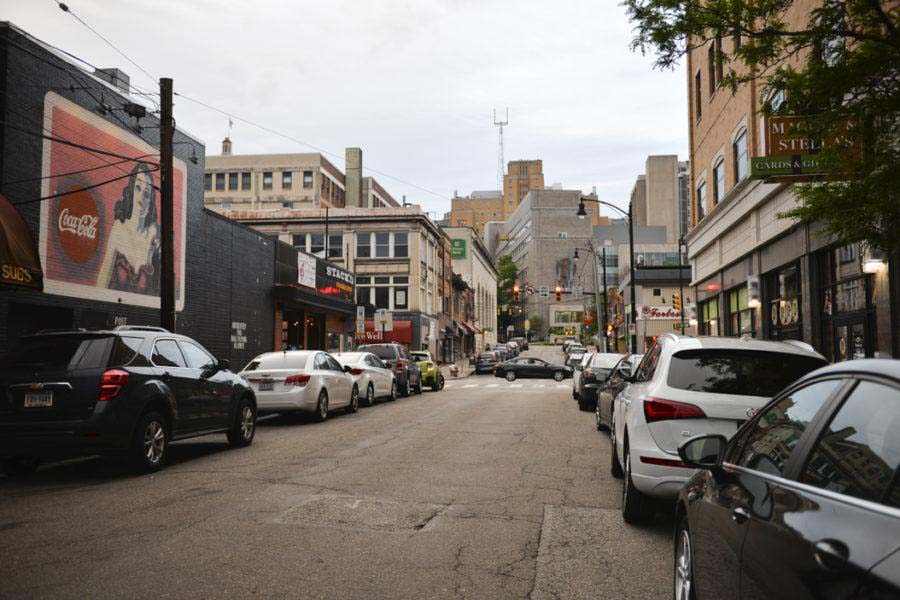Oakland Plan nearing adoption as official City policy
Oakland Avenue in Oakland.
April 5, 2022
The Oakland Plan, touted by the City as a vision for a more livable, accessible and equitable neighborhood, is nearing the end of its journey toward adoption as official City policy.
“We want to continue to build on Oakland’s heritage as a place where generations of people have found opportunity and a home,” Andrew Dash, director of the Department of City Planning, said. “Oakland is a great place to live, work, learn and play in addition to being a center of innovation, healthcare and education.”
Within four main sections — development, community, mobility and infrastructure — the plan outlines a hierarchy of goals, policies and projects.
The 10-year plan sets out dozens of goals, and some notable ones include improving food access, challenging institutional racism, creating more affordable housing opportunities, advocating for cleaner air and maximizing the value of public transit.
Though it has been in the works since fall 2019, the plan “did not start from scratch,” according to Stephanie Joy Everett, project manager for the Oakland Plan.
Everett said it incorporated ideas from several past and ongoing visions for the neighborhood, such as the Oakland Planning and Development Corp.’s Oakland 2025 plan, the Oakland Business Improvement District’s Strategic Plan and a host of institutional master plans from nearby universities and UPMC.
The City Planning Commission initially slated the plan’s public comment period to run from March 7 to April 6, but it has since been extended to May 1.
“After starting the public review process and the public comment period, we did hear from a number of Oakland organizations that there was a desire to get a little more time as they were starting to dig into things,” Dash said at the Planning Commission’s March 22 meeting. “I’ve seen some pretty robust commenting and feedback already.”
This phase of the planning process has brought a new flurry of input on the proposal, with community stakeholders voicing their thoughts in anticipation of a Planning Commission hearing and vote on May 17.
At an OPDC meeting last Tuesday, Executive Director Wanda Wilson expressed several reservations about the plan’s development section.
She said OPDC is particularly concerned about the absence of a specific goal toward “restoring, preserving and fostering homeownership” in the neighborhood, a focus of their Oakland Community Land Trust program. The CLT leases parcels to low-to-moderate income permanent residents, who then own the house on the lot.
Wilson said while inclusionary zoning is a valuable addition, the plan fails to address potential overflows of undergraduate students into pockets of single-family homes within the neighborhood.
Andrea Boykowycz, OPDC’s assistant director, said the community section is underdeveloped and “legit hard to read,” noting that much of OPDC’s work centers around this topic. The section seeks to make Oakland a more inclusive, healthy livable community, while preserving cultural heritage.
“This chapter is the least finished of all the plan chapters,” Boykowycz said. “The connections between the goals, the policies, the projects and the programs are the hardest to navigate and understand of all of the chapters.”
Representatives from both OPDC and OBID sit on the plan’s steering committee, which includes a wide array of community stakeholders and representatives from Pitt to several City councilors. The committee has worked with City officials to help develop the plan, solicit feedback and outline ways to implement projects and programs outlined in the plan.
OBID has yet to provide extensive public feedback as OPDC, but CEO Georgia Petropoulos said the organization has formed a working group to review the plan.
“Even after three years of hard work developing the draft, our OBID stakeholders continue to be committed to the Oakland Plan process and have volunteered time to review and provide input to the important effort,” Petropoulos said.
The Oakland Plan will guide City policy once adopted by the Planning Commission, though City Council must still review the zoning portion. These proposals, including new mixed-use areas along Oakland’s core arteries and the introduction of inclusionary zoning, will then arrive at Mayor Ed Gainey’s desk for final approval.
A section of this zoning package, known as the Urban Center-Mixed Use classification, is shared with Walnut Capital’s Oakland Crossings development plan for Central and South Oakland.
Petropoulos said the plan’s zoning changes will be most impactful toward advancing Oakland’s commercial district. According to the EngagePGH website, the proposal to rezone the Forbes and Fifth avenues corridor will “better support employment activities” by easing the construction of taller builders and limiting residential development.
As the comment process unfolds, Wilson said the plan needs to make room for public feedback before the final Planning Commission hearing and vote.
“We would like to see changes made to this. We would like to see people’s input incorporated,” Wilson said. “We deserve a plan document that works well for our community and speaks to our community’s needs.”








